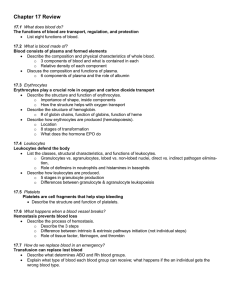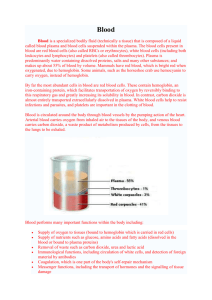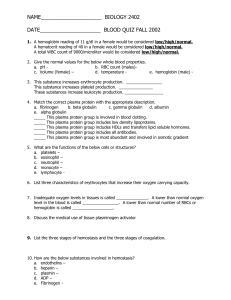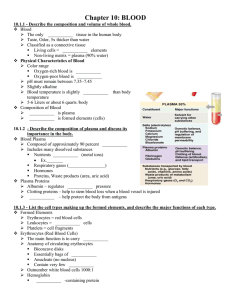Chapter 17 Blood
advertisement
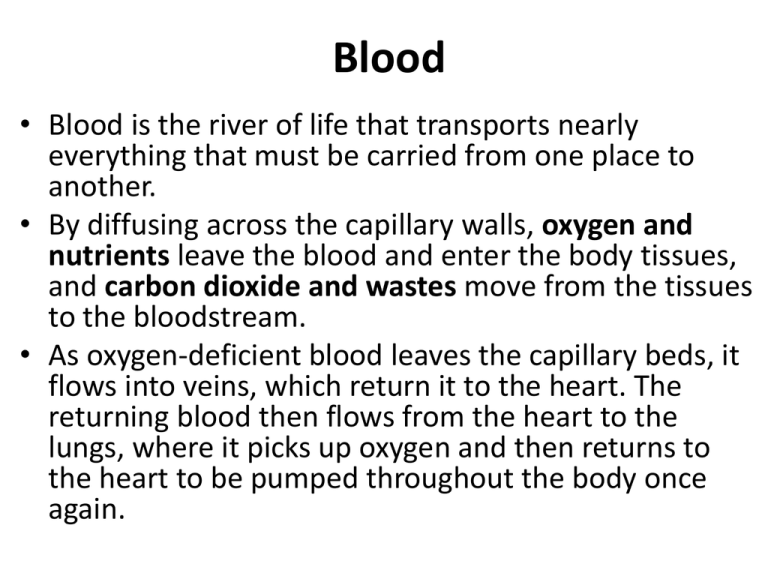
Blood • Blood is the river of life that transports nearly everything that must be carried from one place to another. • By diffusing across the capillary walls, oxygen and nutrients leave the blood and enter the body tissues, and carbon dioxide and wastes move from the tissues to the bloodstream. • As oxygen-deficient blood leaves the capillary beds, it flows into veins, which return it to the heart. The returning blood then flows from the heart to the lungs, where it picks up oxygen and then returns to the heart to be pumped throughout the body once again. Blood Composition • Blood is the only fluid tissue in the body. • The microscope reveals that it has both cellular and liquid components. • Blood is a specialized type of connective tissue in which living blood cells, the formed elements, are suspended in a nonliving fluid matrix called plasma (plaz′mah). • The collagen and elastic fibers typical of other connective tissues are absent from blood, but dissolved fibrous proteins become visible as fibrin strands during blood clotting. If a sample of blood is spun in a centrifuge, the heavier formed elements are packed down by centrifugal force and the less dense plasma remains at the top . • Most of the reddish mass at the bottom of the tube is erythrocytes (ĕ-rith′ro-sīts; erythro = red), the red blood cells that transport oxygen. • A thin, whitish layer called the buffy coat is present at the erythrocyte-plasma junction. This layer contains leukocytes (leuko = white), the white blood cells that act in various ways to protect the body, and platelets, cell fragments that help stop bleeding. • • • Erythrocytes normally constitute about 45% of the total volume of a blood sample, a percentage known as the hematocrit. • Normal hematocrit values vary. In healthy males the norm is 47% ± 5%; in females it is 42% ± 5%. • Leukocytes and platelets contribute less than 1% . • Plasma makes up 55% of whole blood. Physical Characteristics and Volume -Blood is a sticky, opaque fluid . - Depending on the amount of oxygen it is carrying, the color of blood varies from scarlet (oxygen rich) to dark red (oxygen poor). - Blood is more dense than water and about five times more viscous, largely because of its formed elements. - Blood is slightly alkaline, with a pH between 7.35 and 7.45, and its temperature (38°C or 100.4°F) is always slightly higher than body temperature. - Blood accounts for approximately 8% of body weight. Its average volume in healthy adult males is 5–6 L somewhat greater than in healthy adult females (4–5 L). Functions of blood 1-Distribution - Delivering oxygen from the lungs and nutrients from the digestive tract to all body cells. - Transporting metabolic waste products from cells to elimination sites (to the lungs and to the kidneys . - Transporting hormones from the endocrine organs to their target organs. 2-Regulation - Maintaining appropriate body temperature - Maintaining normal pH in body tissues. - Maintaining adequate fluid volume in the circulatory system. 3-Protection - Preventing blood loss. - Preventing infection. Blood Plasma Blood plasma is a straw-colored, sticky fluid. Although it is mostly water (about 90%), plasma contains over 100 different dissolved solutes, including nutrients, gases, hormones, wastes and products of cell activity, ions, and proteins. Plasma proteins • Accounting for about 8% by weight of plasma volume, are the most abundant plasma solutes. • Except for hormones and gamma globulins, most plasma proteins are produced by the liver. • Plasma proteins serve a variety of functions, but they are not taken up by cells to be used as fuels or metabolic nutrients as are most other plasma solutes, such as glucose, fatty acids, and amino acids. • Albumin (al-bu′min) accounts for some 60% of plasma protein. It is an important blood buffer, and is the major blood protein contributing to the plasma osmotic pressure (the pressure that helps to keep water in the bloodstream). (Sodium ions are the other major solute contributing to blood osmotic pressure.) • However, assuming a healthy diet, plasma composition is kept relatively constant by various homeostatic mechanisms. • For example, when blood protein levels drop undesirably, the liver makes more proteins; and when the blood starts to become too acidic (acidosis), both the respiratory system and the kidneys are called into action to restore plasma’s normal, slightly alkaline pH. • In addition to transporting various solutes around the body, plasma distributes heat (a by-product of cellular metabolism) throughout the body. Formed Elements The formed elements of blood are all formed from one mother cell called hemocytoblast . They are :erythrocytes, leukocytes, and platelets. (1) Two of the three are not even true cells: -Erythrocytes have no nuclei or organelles, and -platelets are cell fragments. Only leukocytes are complete cells. (2) Most of the formed elements survive in the bloodstream for only a few days. (3) Blood cells do not divide, they are continuously renewed by division of cells in bone marrow, where they originate. -Erythrocytes vastly outnumber the other types of formed elements. Erythrocytes Erythrocytes or red blood cells (RBCs) are small cells, shaped like biconcave discs—flattened discs with depressed centers -they appear lighter in color at their thin centers than at their edges. Mature erythrocytes are bound by a plasma membrane, but lack a nucleus (are anucleate) and have essentially no organelles. In fact, they are little more than “bags” of hemoglobin (Hb), the RBC protein that functions in gas transport. Erythrocytes are flexible to change shape as they are carried passively through capillaries with diameters smaller than themselves and then to resume their biconcave shape. • Because erythrocytes lack mitochondria, they do not consume any of the oxygen they are transporting, making them very efficient oxygen transporters indeed. • Erythrocytes are the major factor contributing to blood viscosity. Women typically have a lower red blood cell count than men [4.3–5.2 million cells per microliter (1 µl = 1 mm3) of blood versus 5.1–5.8 million cells/µl respectively]. • When the number of red blood cells increases beyond the normal range, blood viscosity rises and blood flows more slowly. Similarly, as the number of red blood cells drops below the lower end of the range, the blood thins and flows more rapidly. Function of Erythrocytes Transport respiratory gases (oxygen and carbon dioxide) . • Hemoglobin, the protein that makes red blood cells red, binds easily and reversibly with oxygen, and most oxygen carried in blood is bound to hemoglobin. • Normal values for hemoglobin are : - in infants 14–20 g/100 ml, - in adult males 13–18 g/100 ml, and - in adult females. 12–16 g/100 ml • Hemoglobin is made up of the protein globin bound to the red heme pigment. Globin consists of four polypeptide chains—two alpha (α) and two beta (β)— each bound to a heme group. Each heme group bears an atom of iron. • Oxygen loading occurs in the lungs, and the hemoglobin is now called oxyhemoglobin . • Oxygen unloading occurs in the tissues, the resulting deoxyhemoglobin, or reduced hemoglobin, becomes dark red. • About 20% of the carbon dioxide transported in the blood combines with hemoglobin (carbaminohemoglobin = carboxyhemoglobin)) Carbon dioxide loading occurs in the tissues, and CO2 unloading occurs in the lungs. Production of blood cells Blood cell formation is referred to as hematopoiesis or hemopoiesis. This process occurs in the red bone marrow. In adults, red marrow is found chiefly in the bones of the axial skeleton and girdles, and in the proximal epiphyses of the humerus and femur. Each type of blood cell is produced in different numbers in response to changing body needs and different regulatory factors. As they mature, they migrate to enter the bloodstream. Regulation and Requirements for Erythropoiesis The balance production and destruction is important because: - too few erythrocytes leads to tissue hypoxia -too many makes the blood undesirably viscous. Erythropoiesis is controlled by: 1-Dietary Requirements materials required for erythropoiesis include—amino acids, lipids,iron and carbohydrates and is available from the diet. 2-Hormonal Controls The direct stimulus for erythrocyte formation is provided by erythropoietin (EPO. Normally, a small amount of EPO circulates in the blood at all times and sustains red blood cell production at a basal rate. Although the liver produces some, the kidneys play the major role in EPO production. When certain kidney cells become hypoxic (i.e., have inadequate oxygen), they accelerate erythropoietin release. The drop in normal blood oxygen levels that triggers EPO formation can result from: • 1. Reduced numbers of red blood cells due to hemorrhage or excessive RBC destruction • 2. Insufficient hemoglobin per RBC (as in iron deficiency) • 3. Reduced availability of oxygen, as might occur at high altitudes or during pneumonia. Fate and Destruction of Erythrocytes Red blood cells are anucleate cells so unable to synthesize new proteins, to grow, or to divide. Erythrocytes become “old” as they lose their flexibility and become increasingly rigid and fragile, and their contained hemoglobin begins to degenerate. Red blood cells have a useful life span of 100 to 120 days, after which they become trapped and fragment in smaller circulatory channels, particularly in those of the spleen. For this reason, the spleen is sometimes called the “red blood cell graveyard.” Erythrocyte Disorders A- Anemias : is a condition in which the blood has abnormally low oxygen-carrying capacity. Anemic individuals are fatigued, often pale, short of breath, and chilly. • Common causes of anemia include the following: 1. An insufficient number of red blood cells. a- Hemorrhagic anemias . b- Hemolytic anemias (he″mo-lit′ik), erythrocytes rupture, or lyse, prematurely. Hemoglobin abnormalities, transfusion of mismatched blood, and certain bacterial and parasitic infections are possible causes. c- Aplastic anemia may result from destruction or inhibition of the red marrow by certain drugs and chemicals, ionizing radiation, or viruses. 2. Low hemoglobin content. When hemoglobin molecules are normal, but erythrocytes contain fewer than the usual number, a nutritional anemia is always suspected. a- Iron-deficiency anemia b-Pernicious anemia is due to a deficiency of vitamin B12. A substance called intrinsic factor, produced by the stomach mucosa, must be present for vitamin B12 to be absorbed by intestinal cells. In most cases of pernicious anemia, intrinsic factor is deficient. c- Folate –deficiency anemia 3. Abnormal hemoglobin. Production of abnormal hemoglobin usually has a genetic basis. Two such examples, thalassemia and sickle-cell anemia.In both diseases the globin part of hemoglobin is abnormal and the erythrocytes produced are fragile and rupture prematurely. B-Polycythemia (pol″e-si-the′me-ah; “many blood cells”) is an abnormal excess of erythrocytes that increases blood viscosity. a- Polycythemia vera, a bone marrow cancer, is characterized by high RBC count so severely impairing circulation. b- Secondary polycythemias result when less oxygen is available or EPO production increases as in individuals living at high altitudes. RBC counts of 6–8 million/µl are common in such people. Leukocytes -Leukocytes (leuko = white), or white blood cells (WBCs), are the only formed elements that are complete cells, with nuclei and the usual organelles. -Accounting for less than 1% of total blood volume. On average, there are 4800–10,800 WBCs/µl (mm3) of blood. - They form a mobile army that helps protect the body from damage by bacteria, viruses, parasites, toxins, and tumor cells. - They are able to slip out of the capillary blood vessels—a process called diapedesis . - Once out of the bloodstream, leukocytes move through the tissue spaces by amoeboid motion . - They follow molecules released by damaged cells or other leukocytes, a phenomenon called positive chemotaxis. Types of leukocytes Granulocytes WBCs that has visible cytoplasmic granules. Three types: • Neutrophils (nu′tro-filz), the most numerous ( 50 – 70%) It increase explosively during acute bacterial infections. • Eosinophils (e″o-sin′o-filz) ,2–4% of all leukocytes . It counterattack against parasitic worms and may also lessen the severity of allergies by inactivating certain inflammatory chemicals released during allergic reactions. • Basophils averaging only 0.5–1%. Their cytoplasm contains large, coarse, histamine-containing granules. Histamine is an inflammatory chemical that acts as a vasodilator (makes blood vessels dilate) and attracts other white blood cells to the inflamed site. Agranulocytes WBCs that lack visible cytoplasmic granules. Two types: - Lymphocytes, 25% or more of the WBC, are the second most numerous leukocytes in the blood. * T lymphocytes (T cells) function in the immune response by acting directly against virus-infected cells and tumor cells. * B lymphocytes (B cells) give rise to plasma cells, which produce antibodies (immunoglobulins) that are released to the blood. - Monocytes, 3–8% of WBCs. When leave the bloodstream and enter the tissues, they differentiate into highly mobile macrophages which are active phagocytes, and they are crucial in the body’s defense against viruses, certain intracellular bacterial parasites, and chronic infections such as tuberculosis. Macrophages are also important in activating lymphocytes to mount the immune response. • • • • Production and Life Span of Leukocytes Like erythropoiesis, leukopoiesis, or the production of white blood cells, is stimulated by chemical messengers. The bone marrow stores mature granulocytes and usually contains about ten times more granulocytes than are found in the blood. The life span of granulocytes is very short(0.5 to 9.0 days), most of which die combating invading microorganisms. Monocytes may live for several months. life span of lymphocytes varies from a few days to decades. Leukocyte Disorders -leukocytosis. A white blood cell count of over 11,000 cells/µl is a normal homeostatic response to an infection in the body. -leukopenia is an abnormally low white blood cell count commonly induced by drugs. -Leukemias ,literally “white blood,” refers to a group of cancerous conditions involving white blood cells. -Although tremendous numbers of leukocytes are produced, they are immature and nonfunctional and cannot defend the body in the usual way. -The most common causes of death are internal hemorrhage and overwhelming infections. Platelets Platelets are not cells in the strict sense , they are cytoplasmic fragments of extraordinarily large cells called megakaryocytes . Platelets are essential for the clotting process. By sticking to the damaged site, platelets form a temporary plug that helps seal the break. Because platelets are anucleate, they age quickly and degenerate in about ten days if they are not involved in clotting. Platelet formation(thrombopoiesis) is regulated by a hormone called thrombopoietin. Each cubic millimeter of blood contains between 150,000 and 400,000 of the tiny platelets. Hemostasis If a blood vessel wall breaks, a whole series of reactions is set in motion to accomplish hemostasis (he″mo-sta′sis), or stoppage of bleeding .Without this we would quickly bleed out our entire blood volume from even the smallest cuts. The hemostasis response, which is fast, localized, and carefully controlled, involves many blood coagulation factors(13 factors) normally present in plasma as well as some substances that are released by platelets and injured tissue cells. During hemostasis, three steps occur in rapid sequence: (1) vascular spasms, (2) platelet plug formation, and (3) coagulation, or blood clotting . Blood loss at the site is permanently prevented when fibrous tissue grows into the clot and seals the hole in the blood vessel. Coagulation Coagulation or blood clotting during which blood is transformed from a liquid to a gel, is a multistep process : • A complex substance called prothrombin activator is formed. • Prothrombin activator converts a plasma protein called prothrombin into thrombin, an enzyme. • Thrombin catalyzes the joining of fibrinogen molecules present in plasma to a fibrin mesh, which traps blood cells and effectively seals the hole until the blood vessel can be permanently repaired. Disorders of Hemostasis The two major disorders of hemostasis are : A- Undesirable clotting -A clot that develops and persists in an unbroken blood vessel is called a thrombus. If the thrombus is large enough, it may block circulation to the cells beyond the occlusion and lead to death of those tissues. For example coronary thrombosis, the consequences may be death of heart muscle and a fatal heart attack. - If the thrombus breaks away from the vessel wall and floats freely in the bloodstream, it becomes an embolus (plural: emboli). An embolus is usually no problem until it encounters a blood vessel too narrow for it to pass through; then it becomes an embolism, obstructing the vessel. For example, pulmonary embolisms dangerously impair the ability of the body to obtain oxygen. B- Bleeding Disorders Anything that interferes with the clotting mechanism can result in abnormal bleeding. The most common causes are : -Thrombocytopenia A condition in which the number of circulating platelets is deficient, causing spontaneous bleeding from small blood vessels all over the body. - Impaired Liver Function When the liver is unable to synthesize its usual supply of procoagulants, abnormal, and often severe, bleeding occurs. The causes can range from an easily resolved vitamin K deficiency (common in newborns) to nearly total impairment of liver function (as in hepatitis or cirrhosis). Vitamin K is required by the liver cells for production of the clotting factors. However, vitamin K deficiency can occur if fat absorption is impaired, because vitamin K is a fat-soluble vitamin. - Hemophilias refers to several different hereditary bleeding disorders that have similar signs and symptoms. Hemophilia A, or classical hemophilia, results from a deficiency of factor VIII (antihemophilic factor). It accounts for 77% of cases. Hemophilia B results from a deficiency of factor IX. Both types are X-linked conditions occurring primarily in males. Hemophilia C, a less severe form of hemophilia seen in both sexes, is due to a lack of factor XI. Transfusion and Blood Replacement -Losses of 15–30% cause pallor and weakness. -Loss of more than 30% of blood volume results in severe shock, which can be fatal. - Infusions of packed red cells (whole blood from which most of the plasma has been removed) are preferred for restoring oxygen-carrying capacity. - The usual blood bank procedure involves collecting blood from a donor and then mixing it with an anticoagulant, such as certain citrate or oxalate salts, which prevents clotting by binding with calcium ions. - The shelf life of the collected blood at 4°C is about 35 days. - Blood is most often separated into its component parts so that each component can be used when and where it is needed. Human Blood Groups RBC plasma membranes, like those of all body cells, bear highly specific glycoproteins (antigens) at their external surfaces, which identify each of us as unique from all others. One person’s RBC proteins may be recognized as foreign if transfused into someone with a different red blood cell type, and the transfused cells may be agglutinated (clumped together) and destroyed. Since these RBC antigens promote agglutination, they are more specifically called agglutinogens . At least 30 varieties of RBC antigens are in humans. ABO Blood Groups The ABO blood groups are based on the presence or absence of two agglutinogens(antigens), type A and type B. Depending on the antigen present, a person will be one of the following: A, B, AB, or O. -The O blood group has neither agglutinogen and AB, with both antigens . -The presence of either the A or the B agglutinogen (antigen)results in group A or B, respectively. -To these antigens, there are preformed antibodies called agglutinins (antibodies). The agglutinins act against RBCs carrying ABO antigens that are not present on a person’s own red blood cells. -A newborn lacks these antibodies, but they begin to appear in the plasma within two months and reach adult levels between 8 and 10 years of age. -In a person with neither the A nor the B antigen (group O) possesses both anti-A and anti-B antibodies. -Those with group A blood have anti-B antibodies, while those with group B have anti-A antibodies. Neither antibody is produced in AB individuals. Rh Blood Groups There are 45 different types of Rh agglutinogens, each of which is called an Rh factor. Only three of these, the C, D, and E antigens, are fairly common. The Rh blood typing system is so named because one Rh antigen (agglutinogen D) was originally identified in rhesus monkeys. Later, the same antigen was discovered in humans. Most Americans (about 85%) are Rh+ (Rh positive), meaning that their RBCs carry the D antigen. As a rule, a person’s ABO and Rh blood groups are reported together, for example, O+, A–, and so on. Unlike the ABO system antibodies, anti-Rh antibodies are not spontaneously formed in the blood of Rh– (Rh negative) individuals. However, anti-Rh antibodies are formed in two cases: 1- if an Rh– person receives Rh+ blood, the immune system begins producing anti-Rh antibodies against the foreign antigen Hemolysis does not occur after the first such transfusion because it takes time for the body to start making antibodies. But the second time, and every time thereafter, a typical transfusion reaction occurs in which the recipient’s antibodies attack and rupture the donor RBCs. 2- If Rh– women who are carrying Rh+ babies. The first such pregnancy usually results in the delivery of a healthy baby. But, when bleeding occurs as the placenta detaches from the uterus, the mother may be sensitized by her baby’s Rh+ antigens that pass into her bloodstream. If so, she will form antiRh antibodies (unless treated with antiRh antibodies before or shortly after she has given birth) which blocks the mother’s immune response and prevents her sensitization). (The same precautions are taken in women who have miscarried or aborted the fetus). • If the mother is not treated and becomes pregnant again with an Rh+ baby, her antibodies will cross through the placenta and destroy the baby’s RBCs, producing a condition known as hemolytic disease of the newborn, or erythroblastosis fetalis. The baby becomes anemic and hypoxic. In severe cases, brain damage and even death may result unless transfusions are done before or after birth . The baby’s Rh+ blood is removed, and Rh– blood is infused. Within six weeks, the transfused Rh– erythrocytes have been broken down and replaced with the baby’s own Rh+ cells. • Transfusion Reactions: Blood typing for ABO and Rh is always done before blood is transfused. When mismatched blood is infused, a transfusion reaction occurs in which the donor’s red blood cells are attacked by the recipient’s plasma agglutinins. The agglutination of the foreign red blood cells, clogs small blood vessels throughout the body. During the next few hours, the clumped cells begin to rupture and their hemoglobin is released into the bloodstream. (When the transfusion reaction is exceptionally severe, the RBCs are lysed almost immediately.) • These events (transfusion reaction )lead to two problems: (1) The oxygen-carrying capability of the transfused blood cells is disrupted, and (2) the clumping of red blood cells in small vessels hinders blood flow to tissues beyond those points. • Less apparent, but may be fatal, if circulating hemoglobin passes into the kidney tubules, causing cell death and renal shutdown. • Transfusion reactions can also cause fever, chills, low blood pressure, rapid heartbeat, nausea, vomiting, and general toxicity; but in the absence of renal shutdown, these reactions are rarely lethal. • As indicated before , group O red blood cells bear neither the A nor the B antigen; thus, theoretically this blood group is the universal donor. Since group AB plasma is devoid of antibodies to both A and B antigens, group AB people are theoretically universal recipients and can receive blood from any of the ABO groups. • However, these classifications are misleading, because they do not take into account the other agglutinogens in blood that can trigger transfusion reactions. Blood Typing The importance of determining the blood group of both the donor and the recipient before blood is transfused is very obvious. One drop of anti A and anti B is put on a slide then we add one drop of the blood on each(see the next slide). Typing for the Rh factors is done in the same manner as ABO blood typing. cross matching Because it is critical that blood groups be compatible, cross matching is also done. Cross matching tests for agglutination of donor RBCs by the recipient’s serum, and of the recipient’s RBCs by the donor serum. Restoring Blood Volume When a patient’s blood volume is so low so that blood volume must be replaced immediately to restore adequate circulation. Replacing lost blood volume essentially consists of replacing that isotonic salt solution. Normal saline or a multiple electrolyte solution that mimics the electrolyte composition of plasma (isotonic solutions) are the preferred choices. Volume replacement restores adequate circulation but cannot, of course, replace the oxygen-carrying capacity of the lost red blood cells. Diagnostic Blood Tests -Microscopic studies of the size , shape and color of erythrocytes that predict iron deficiency or pernicious anemia. -Differential white blood cell count, is a valuable diagnostic tool. - Prothrombin time asses the amount of prothrombin - platelet count -Complete blood count (CBC)—are routinely ordered during physical examinations and before hospital admissions. It includes counts of the different types of formed elements, a hematocrit, measurements of hemoglobin content, and size of RBCs. Developmental Aspects of Blood -Early in fetal development , blood cell formation occurs in the liver, and spleen. - By the seventh month, the red marrow has become the primary area and remains so throughout life. -If there is a severe need for blood cell production, however, the liver and the spleen may resume their fetal blood-forming roles. Additionally, inactive yellow bone marrow regions (essentially fatty tissue) may reconvert to active red marrow. -The fetus forms a unique hemoglobin, hemoglobin F, that has a higher affinity for oxygen than does adult hemoglobin (hemoglobin A). It contains two alpha and two gamma (γ) polypeptide chains per globin molecule, instead of the paired alpha and beta chains typical of hemoglobin A. - After birth, fetal erythrocytes carrying HbF are rapidly destroyed and replaced by cells with HbA. The immature liver may be unable to deal with this large quantity of Hb breakdown so physiologic jaundice may develop.
